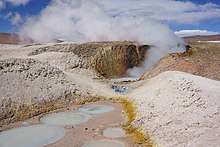Sol de Mañana
Sol de Mañana (Spanish: Morning Sun) is a geothermal area in Sur Lípez Province in the Potosi Department of south-western Bolivia. It extends over 10 km2, between 4800m and 5000m in altitude.

This area is characterized by intense volcanic activity and the sulphur springs field is full of mud lakes and steam pools with boiling mud. Industrial logging was attempted at the end of the 1980s, but is uneconomic. There are still several wells, one of which emits pressurized steam, visible in the morning up to 50 meters high. The major mud lakes are located at 4850m. The field is seismically active.[1]
Sol de Mañana, together with El Tatio, is among the geothermal fields located at high altitude and is associated with the volcanic system of the Altiplano-Puna volcanic complex,[2] as well as with a fault system that connects the two.[3] Sol de Mañana is part of the geothermal system of the Laguna Colorada caldera;[4] Cerro Guacha and Pastos Grandes have been proposed to be the heat sources as well.[5] This geothermal field has been investigated for the potential of geothermal power generation.[6]
The region of Sol de Mañana is volcanic, with extensive exposure of Miocene-Pleistocene materials ranging from andesite to rhyodacite, as well as extensive faulting. Moraines also occur in the area.[7]
Gallery
References
- Pritchard, M.E. (1 June 2014). "Reconnaissance earthquake studies at nine volcanic areas of the central Andes with coincident satellite thermal and InSAR observations". Journal of Volcanology and Geothermal Research. 280: 90–103. doi:10.1016/j.jvolgeores.2014.05.004. ISSN 0377-0273.
- Fernandez-Turiel, J.L. (15 October 2005). "The hot spring and geyser sinters of El Tatio, Northern Chile". Sedimentary Geology. 180 (3–4): 125–147. doi:10.1016/j.sedgeo.2005.07.005. ISSN 0037-0738.
- Tassi, F.; Martinez, C.; Vaselli, O.; Capaccioni, B.; Viramonte, J. (1 November 2005). "Light hydrocarbons as redox and temperature indicators in the geothermal field of El Tatio (northern Chile)". Applied Geochemistry. 20 (11): 2049–2062. doi:10.1016/j.apgeochem.2005.07.013. ISSN 0883-2927.
- Scandiffio, G.; Alvarez, M. (1992). "Geochemical report on the Laguna Colorada geothermal area, Bolivia": 78. Cite journal requires
|journal=(help) - Glennon, Alan; Pfaff, R.M. (2003). "The extraordinary thermal activity of the El Tatio Geysers, Antofagasta Province, Chile" (PDF). GOSA Transactions. 8: 31–78. Retrieved 29 November 2017.CS1 maint: ref=harv (link)
- Rojas, P. Moya (2016). Central and South America: Significant but constrained potential for geothermal power generation. Geothermal Power Generation. pp. 667–715. doi:10.1016/B978-0-08-100337-4.00023-1. ISBN 9780081003374.
- Sullcani, Pedro Rómulo Ramos. "Well data analysis and volumetric assessment of The Sol de Mañana geothermal field, Bolivia". rafhladan.is. United Nations University. Retrieved 7 December 2017.
.jpg)



.jpg)